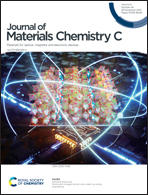Revealing the crystal structures and relative dielectric constants of fluorinated silicon oxides†
Abstract
Low dielectric constant (low-k) fluorinated silica is one of the most important materials used in ultralarge scale integrated circuits (ULSIs); however, it still remains unclear what the minimum k possible using fluorinated silica actually is because the levels of fluorine doped into silica are high enough that some hitherto unknown fluorinated silica materials with the best performance are expected to be formed. In this study we answer this question by revealing the crystal structures of fluorinated silica across the fluorine concentration range. Using the evolutionary algorithm USPEX, we perform a global structure search across the SiO2–SiF4 system. We discover a number of thermodynamically stable/metastable structures of fluorinated silica. Based on these predicted structures, we calculate their k and investigate the effects of fluorine on the structure and k of fluorinated silica. We find that the structural connectivity and k of fluorinated silica are both decreased with the increasing fluorine content. The lowest k of fluorinated silica with 3D topological connectivity is 2.8, providing a target and an important hard-limit to the application of fluorinated silica in the fabrication of ULSIs. We suggest that the further way to achieve a lower k in 3D-connectivity SiOF compounds is to decrease their density. The present study provides a guidance for discovering new intrinsic (ultra)low-k materials with the best performance in a given chemical system.



 Please wait while we load your content...
Please wait while we load your content...